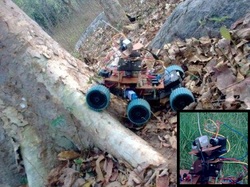Project 7

TITLE: ALL TERRAIN REMOTE SPY VEHICLE-2 (version - 2)
Description:
After exhibiting ATRSV -1 in couple of events, I have gathered some feedback from the visitors. This feedback gave my thoughts some extra work in modifying ATRSV - 1 into ATRSV - 2. Version - 1 bot is having a wireless camera which is stationary with respect to the bot where as camera on version - 2 is a wireless camera with two degrees of freedom (pan and tilt). More over ATRSV - 2 is having lights on it which are automatic i.e., when the bot travels in darkness, these lights turn on automatically. I have used LDR as a sensor to detect the intensity of ambient light.
The important aspect of this project is its flexible body. The mechanical structure of ATRSV - 2 is slightly modified when compared to ATRSV - 1. Its structure is designed into three compartments and are joined using hinges in order to provide flexibility on different surfaces. More over this bot is powered by six wheel drive. As this bot is built by joining three compartments, at any instant of time at least four wheel are in contact with the ground which in turn helps the bot to move on different terrains with much ease.
This robot can be operated using a wireless remote. Using the video transmitted by the wireless camera as visual aid, we can control the bot in an area away from the controller. This bot is having an on board smoke detection sensor which can be used to detect fire and can be used to alert people around it by emitting sound from the buzzer.
Results:
After testing ATRSV - 1, the mechanical structure has been slightly modified. Its capabilities have improved over its first version. With the feedback provided by the visitors at TECH EXPO's, I have added some sensors like LDR and Smoke detectors. With this experience, I have learnt the applications and importance of sensors in robotics.
References:
Description:
After exhibiting ATRSV -1 in couple of events, I have gathered some feedback from the visitors. This feedback gave my thoughts some extra work in modifying ATRSV - 1 into ATRSV - 2. Version - 1 bot is having a wireless camera which is stationary with respect to the bot where as camera on version - 2 is a wireless camera with two degrees of freedom (pan and tilt). More over ATRSV - 2 is having lights on it which are automatic i.e., when the bot travels in darkness, these lights turn on automatically. I have used LDR as a sensor to detect the intensity of ambient light.
The important aspect of this project is its flexible body. The mechanical structure of ATRSV - 2 is slightly modified when compared to ATRSV - 1. Its structure is designed into three compartments and are joined using hinges in order to provide flexibility on different surfaces. More over this bot is powered by six wheel drive. As this bot is built by joining three compartments, at any instant of time at least four wheel are in contact with the ground which in turn helps the bot to move on different terrains with much ease.
This robot can be operated using a wireless remote. Using the video transmitted by the wireless camera as visual aid, we can control the bot in an area away from the controller. This bot is having an on board smoke detection sensor which can be used to detect fire and can be used to alert people around it by emitting sound from the buzzer.
Results:
After testing ATRSV - 1, the mechanical structure has been slightly modified. Its capabilities have improved over its first version. With the feedback provided by the visitors at TECH EXPO's, I have added some sensors like LDR and Smoke detectors. With this experience, I have learnt the applications and importance of sensors in robotics.
References:
- Mobile Robots Inspiration to Implementation - Flynn and Jones
- Robot Builders Bonanza - Gordon Mc comb
- Digital Electronics Demystified Myke Predko
Click here for videos

